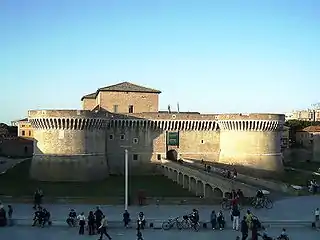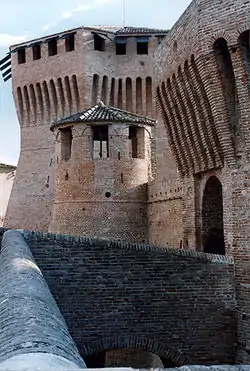Della Rovere
The Della Rovere family (pronounced [della ˈroːvere]; literally "of the oak tree") was a noble family of Italy. It had humble origins in Savona, in Liguria, and acquired power and influence through nepotism and ambitious marriages arranged by two Della Rovere popes: Francesco Della Rovere, who ruled as Sixtus IV from 1471 to 1484) and his nephew Giuliano, who became Julius II in 1503.[1] Sixtus IV built the Sistine Chapel, which is named for him. The Basilica of San Pietro in Vincoli in Rome is the family church of the Della Rovere. Members of the family were influential in the Church of Rome, and as dukes of Urbino; that title was extinguished with the death of Francesco Maria II in 1631, and the family died out with the death of his granddaughter Vittoria, Grand Duchess of Tuscany.[1]
| Della Rovere | |
|---|---|
 | |
| Country | |
| Final head | Vittoria della Rovere, died 1694 |
| Titles | Duke of Urbino |
| Estate(s) | |
History
Francesco Della Rovere was born into a poor family in Liguria in north-west Italy in 1414, the son of Leonardo della Rovere of Savona.[1] He was elected pope in 1471. As Sixtus IV he was both wealthy and powerful, and at once set about giving power and wealth to his nephews of the Della Rovere and Riario families. Within months of his election, he had made Giuliano della Rovere (the future pope Julius II) and Pietro Riario both cardinals and bishops; four other nephews were also made cardinals.[2]:252[3]:128 He made Giovanni Della Rovere, who was not a priest, prefect of Rome, and arranged for him to marry into the da Montefeltro family, dukes of Urbino. Sixtus claimed descent from a noble Della Rovere family, the counts of Vinovo in Piemonte, and adopted their coat-of-arms.[4]
Guidobaldo da Montefeltro adopted Francesco Maria I della Rovere, his sister's child and nephew of Pope Julius II. Guidobaldo I, who was heirless, called Francesco Maria at his court, and named him as heir of the Duchy of Urbino in 1504, this through the intercession of Julius II. In 1508, Francesco Maria inherited the duchy thereby starting the line of Rovere Dukes of Urbino. That dynasty ended in 1626 when Pope Urban VIII incorporated Urbino into the papal dominions. As compensation to the last sovereign duke, the title only could be continued by Francesco Maria II, and after his death by his heir, Federico Ubaldo.
Vittoria, last descendant of the della Rovere family (she was the only child of Federico Ubaldo), married Ferdinando II de' Medici, Grand Duke of Tuscany. They had two children: Cosimo III, Tuscany's longest reigning monarch, and Francesco Maria de' Medici, a prince of the Church.
Rovere Dukes of Urbino (1508)
- Francesco Maria I della Rovere (1490–1538)
- Guidobaldo II della Rovere (1514–1574)
- Francesco Maria II della Rovere (1549–1631) - duchy abolished, title continued
- Federico Ubaldo della Rovere (1605–1623) - title became extinct with his death.
Other people with the same surname
Among the many people who did not belong to this family, but bore the same name, are:
- the Della Rovere family, counts of Vinovo, among them:
- Domenico della Rovere of Vinovo, cardinal, who built the Castello Della Rovere there
- his brother Cristoforo della Rovere of Vinovo[5]
and various artists, including:
- the brothers Giovan Battista Della Rovere and Giovan Mauro Della Rovere, both known as "il Fiamminghino"
- an unrelated Lombard family of painters and illuminators active in the seventeenth century.[6]
.jpg.webp) Francesco della Rovere, later Sixtus IV
Francesco della Rovere, later Sixtus IV Giuliano della Rovere, later Julius II
Giuliano della Rovere, later Julius II Francesco Maria I della Rovere
Francesco Maria I della Rovere_-_Portrait_of_Guidobaldo_II_della_Rovere%252C_Duke_of_Urbino_-_1956.7.1_-_Yale_University_Art_Gallery.jpg.webp) Guidobaldo II della Rovere
Guidobaldo II della Rovere Francesco Maria II della Rovere
Francesco Maria II della Rovere Vittoria della Rovere
Vittoria della Rovere

 Rocca Della Rovere in Senigallia
Rocca Della Rovere in Senigallia Rocca Roveresca in Mondavio
Rocca Roveresca in Mondavio Palazzo Della Rovere in San Lorenzo in Campo
Palazzo Della Rovere in San Lorenzo in Campo
References
- Della Róvere (in Italian). Enciclopedie on line. Rome: Istituto dell'Enciclopedia Italiana. Accessed May 2018.
- Vincent Cronin (1992 [1967]). The Florentine Renaissance. London: Pimlico. ISBN 0712698744.
- Christopher Hibbert (1979 [1974]). The Rise and Fall of the House of Medici. Harmondsworth, Middlesex: Penguin. ISBN 0140050906.
- Giuseppe Castellani (1931). Della Rovere (in Italian). Enciclopedia Italiana. Rome: Istituto dell'Enciclopedia Italiana. Accessed May 2018.
- François Ch. Udinet (1989). Della Rovere, Domenico (in Italian). Dizionario Biografico degli Italiani, volume 37. Rome: Istituto dell'Enciclopedia Italiana. Accessed May 2018.
- Giovanni Romano (1989). Della Rovere (in Italian). Dizionario Biografico degli Italiani, volume 37. Rome: Istituto dell'Enciclopedia Italiana. Accessed May 2018.
Further reading
- Ian Verstegen (2007). Patronage and Dynasty: the Rise of the Della Rovere in Renaissance Italy. Kirksville, Missouri: Truman State University Press.